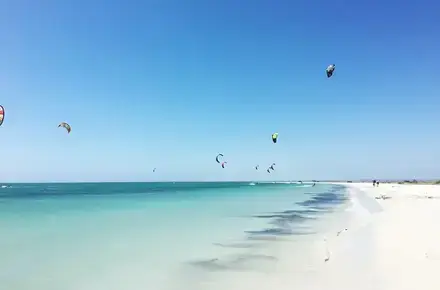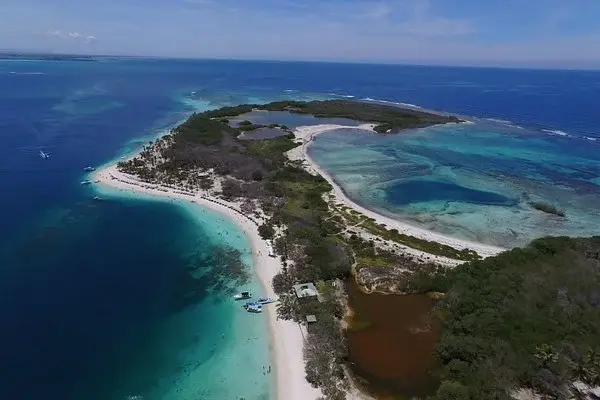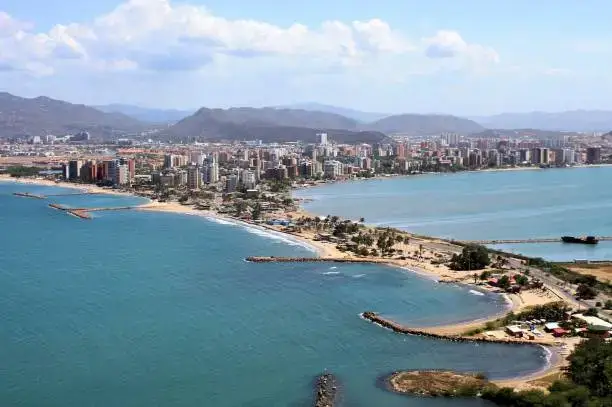Best Kitesurfing Spots in Venezuela

Welcome to an in-depth exploration of the best kitesurfing spots in Venezuela. From the captivating island of Margarita to the picturesque Adícora, the stunning Los Roques Archipelago, and the vibrant Chichiriviche and Puerto La Cruz, each location promises ideal wind and water conditions for kitesurfing enthusiasts.
In addition to uncovering these exceptional destinations, we will also shed light on the various kitesurfing schools available, ensuring an immersive and fulfilling experience for beginners and experienced riders alike. Join us as we delve into the thrilling world of kitesurfing in Venezuela.
Weather
Venezuela’s coastal areas generally experience a tropical climate with relatively high temperatures and distinct wet and dry seasons.

Here’s a general overview of the average yearly weather in Venezuela’s coastal regions:
Temperature:
- High temperatures are common throughout the year, typically ranging from 25°C to 35°C (77°F to 95°F).
- Coastal areas tend to have a more moderate temperature compared to inland regions.
Wet and Dry Seasons:
- Venezuela experiences a distinct wet season and dry season.
- The wet season typically runs from May to October. During this period, coastal areas may receive heavy rainfall and experience higher humidity levels.
- The dry season usually occurs from November to April, with less rainfall and more stable weather.
Humidity:
Coastal areas can be quite humid, especially during the wet season. Humidity levels may decrease during the dry season.
Trade Winds:
Coastal areas, particularly those facing the Caribbean Sea, can experience trade winds. These winds contribute to the overall climate and can influence weather patterns.
Hurricane Risk:
Venezuela’s northern coast is in the hurricane belt, and while direct hits are infrequent, there is a potential risk during the Atlantic hurricane season, which typically runs from June to November.
Wind conditions
Venezuela boasts favorable wind conditions that contribute to its reputation as one of the best kitesurfing destinations in the world. The wind patterns in Venezuela are influenced by the trade winds, which blow consistently from the northeast.
During the dry season, which typically occurs from November to April, the trade winds are often more consistent. They contribute to stable and drier weather conditions along the coast.
In the wet season, which usually spans from May to October, the trade winds may still be present but can be accompanied by increased moisture. This season is associated with higher chances of rainfall and is influenced by factors such as the Intertropical Convergence Zone (ITCZ).
Venezuela’s northern coast is within the Atlantic hurricane belt. During the hurricane season, which runs from June to November, the trade winds play a role in steering hurricanes away from the coast. However, they can also influence weather patterns and contribute to storm development in the region.
Water conditions
Kitesurfing in Venezuela offers favorable water conditions for riders to enjoy their sessions. The country boasts various kitesurfing spots with different characteristics, including wave size, water temperature, current strength, water visibility, and tidal range.
For those seeking big waves, spots like Adícora and Los Roques Archipelago are popular choices. Adícora is known for its consistent winds and small to medium-sized waves, while Los Roques Archipelago offers larger swells for more experienced riders.
The water temperature in Venezuela is generally warm, making it comfortable to kitesurf without the need for a wetsuit. On average, the sea temperature in Venezuela tends to range between 26°C to 30°C (79°F to 86°F).
Water visibility is generally good, allowing riders to fully enjoy the beautiful underwater scenery. Lastly, the tidal range can also differ, so it’s essential for kitesurfers to check the tide charts before heading out.

🏄 Margarita Island
Located off the northeastern coast of Venezuela, Margarita Island offers kitesurfers a diverse range of water conditions and kiteboarding opportunities. Here are some key features that make it a top kitesurfing spot:
Best beaches: Margarita Island boasts beautiful sandy beaches like Playa El Yaque, known for its consistent winds and flat water ideal for kitesurfing. It is also home to Playa Parguito, which offers great wave riding conditions for more experienced riders.
Kitesurfing equipment: The island has several kitesurfing shops and rental facilities where you can find a wide range of kites, boards, and other equipment. You can easily rent or purchase gear to suit your preferences and skill level.
Local accommodations: Margarita Island offers a variety of accommodations, ranging from budget-friendly guesthouses to luxury resorts. Many of these accommodations are located near the kitesurfing spots, making it convenient for enthusiasts to access the beach and enjoy their kitesurfing sessions.
With regular kitesurfing events, such as the KiteFest Margarita, the island also provides opportunities to participate in competitions or watch professionals in action.

🏄 Adícora
Adícora, a renowned kitesurfing destination in Venezuela, offers kitesurfers a unique combination of wind conditions and picturesque landscapes. With consistent trade winds blowing from the northeast, kitesurfing conditions in Adícora are ideal for both beginners and experienced riders.
The best time to visit is from November to May, when the winds are strongest and the waves are at their peak. Apart from kitesurfing, Adícora also offers a range of local attractions to explore, including beautiful beaches, vibrant markets, and delicious seafood restaurants.
For accommodation options, there are several hotels and guesthouses available in the area, ranging from budget-friendly to luxury.

🏄 Los Roques Archipelago
The allure of the Los Roques Archipelago lies in its pristine waters and breathtaking natural beauty. This stunning destination in Venezuela offers kitesurfers an unforgettable experience. Here are some highlights of kitesurfing in Los Roques Archipelago:
Best beaches: Los Roques Archipelago is home to some of the most beautiful beaches in the world, with powdery white sand and crystal-clear turquoise waters. These idyllic beaches provide the perfect backdrop for kitesurfing.
Island hopping: With over 350 islands and cays, Los Roques Archipelago offers endless opportunities for island hopping. Explore the different islands and discover new kitesurfing spots each day.
Snorkeling spots: In addition to kitesurfing, Los Roques Archipelago is renowned for its incredible snorkeling spots. Dive beneath the surface and encounter vibrant coral reefs and a diverse array of marine life.
From thrilling kitesurfing sessions to underwater adventures, Los Roques Archipelago offers it all. After a day on the water, be sure to indulge in the delicious local cuisine, which includes fresh seafood dishes that will tantalize your taste buds.

🏄 Chichiriviche
Chichiriviche is a popular kitesurfing spot in Venezuela, known for its excellent wind and water conditions. With its stunning beaches and vibrant atmosphere, it attracts kitesurfing enthusiasts from all over the world.
The area offers several kite spots suitable for all skill levels, making it a great destination for both beginners and experienced riders. Apart from kitesurfing, Chichiriviche boasts a range of local attractions, including nearby islands and coral reefs perfect for snorkeling and diving.
When it comes to accommodation options, visitors can choose from a variety of beachfront hotels and guesthouses that cater to different budgets. After a thrilling day on the water, there are numerous restaurants and bars where visitors can indulge in delicious local cuisine and relax with a refreshing drink while enjoying the beautiful sunset.

🏄 Puerto La Cruz
Puerto La Cruz offers excellent kitesurfing conditions, making it a desirable destination for enthusiasts of the sport. Here are the top kitesurfing spots in Puerto La Cruz:
- Safety measures: The kitesurfing community in Puerto La Cruz takes safety seriously. Local instructors provide safety briefings and ensure that all necessary precautions are taken to protect riders from potential hazards.
- Best time to visit: The best time to visit Puerto La Cruz for kitesurfing is during the dry season, from November to April. During this period, the winds are consistent, ranging from 15 to 25 knots, providing ideal conditions for kitesurfing.
In terms of accommodation options, Puerto La Cruz offers a range of hotels and guesthouses to suit different budgets. Additionally, equipment rental is readily available, allowing visitors to enjoy kitesurfing even if they don’t have their own gear.
Kitesurfing schools
Venezuela has kitesurfing schools and instructors offering lessons and equipment rentals, particularly in popular coastal areas. However, the availability of kitesurfing schools can vary by region and may be influenced by factors such as tourism trends, local demand, and economic conditions.
Popular kitesurfing destinations in Venezuela, such as Margarita Island and Adícora, have historically had kitesurfing schools that cater to both beginners and experienced kiteboarders. These schools typically offer lessons with certified instructors, equipment rentals, and sometimes accommodation packages.
It’s important to note that the situation may have changed since my last update, and it’s advisable to check the current status and availability of kitesurfing schools in Venezuela through recent travel resources, local tourism websites, or by contacting local authorities.
Furthermore, due to any potential changes in political or economic conditions, it’s recommended to ensure the safety and stability of the region before planning a kitesurfing trip.
If you have a specific location in mind, you may want to reach out to local tourism offices or online kitesurfing communities to get the most up-to-date information on kitesurfing schools and conditions in that area.
Other things to do
Venezuela’s islands and coastal regions offer a diverse range of activities beyond kitesurfing. Here are some other things you can enjoy on the islands and along the coast of Venezuela:
- Beach Relaxation:
- Explore the beautiful beaches and indulge in relaxation. Venezuela’s coast is adorned with sandy shores and clear waters, making it an ideal destination for sunbathing and beachcombing.
- Snorkeling and Diving:
- Discover the vibrant underwater world through snorkeling or diving. Venezuela’s coastal areas, including the Los Roques Archipelago, offer excellent opportunities to explore coral reefs and marine life.
- Boat Tours and Cruises:
- Take boat tours or cruises to explore the surrounding islands and coastal landscapes. Many operators offer excursions to nearby cays and natural attractions.
- Fishing:
- Enjoy fishing in the rich waters around Venezuela. The coastal areas provide opportunities for both deep-sea and shore fishing. Many fishing charters cater to enthusiasts of all skill levels.
- Hiking and Nature Exploration:
- Explore the natural beauty of Venezuela’s islands by hiking. Some islands, like Isla Margarita, have trails that lead to scenic viewpoints and natural attractions.
- Historical and Cultural Sites:
- Visit historical and cultural sites along the coast. Explore colonial architecture, museums, and landmarks in coastal towns like Coro, a UNESCO World Heritage Site.
- Bird Watching:
- Venezuela is home to diverse bird species. Take advantage of bird watching opportunities, especially in areas with rich biodiversity such as the Los Roques Archipelago.
- Culinary Experiences:
- Sample local cuisine and seafood. Coastal regions often feature delicious dishes influenced by the proximity to the sea.
- Windsurfing and Paddleboarding:
- If you enjoy water sports but prefer something different from kitesurfing, try windsurfing or paddleboarding. Many coastal areas offer equipment rentals and lessons.
- Island-Hopping:
- Explore multiple islands by engaging in island-hopping adventures. Each island in Venezuela has its unique charm and attractions.
- Wildlife Watching:
- Look for wildlife, including marine life and seabirds. The coastal areas and islands are often habitats for various species.
- Cultural Festivals:
- Check the local calendar for cultural events and festivals. Coastal communities may host celebrations with music, dance, and traditional festivities.
Remember to check local regulations, weather conditions, and safety guidelines when engaging in water and outdoor activities. Always respect the natural environment and local communities to ensure a positive and sustainable travel experience.

Link exchange is nothing else but it is simply placing the other person’s website link on your page at suitable place and other person will also do similar in support of you.
I’m interested.
I’m extremely impressed with your writing skills and also with the layout on your blog.
Is this a paid theme or did you modify it yourself?
Either way keep up the nice quality writing, it’s rare to see a nice blog
like this one today.
Thanks! I’m using the standard Astra theme.